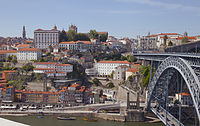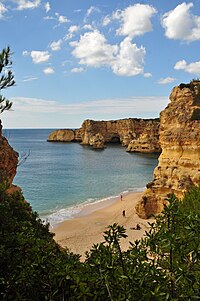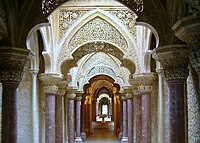Lisbon , Portugal's capital.Porto , Portugal's fourth largest municipalityThe Marinha Beach in Lagoa is considered by the Michelin Guide as one of the 10 most beautiful beaches in Europe and as one of the 100 most beautiful beaches in the world. The Algarve region leads in overnight stays. A view of Óbidos . Panoramic view of Nazaré and its beach. Shrine of Our Lady of Fátima .University of Coimbra , one of the oldest universities in the world.Mondego River in Coimbra .Pena National Palace in Sintra , an UNESCO World Heritage Site .Monserrate Palace in Sintra Pico , Azores , besides being the highest mountain in Portugal, it is a wine region whose landscape is protected as world heritage.Aveiro is known as the "Portuguese Venice".The Douro river in Northern Portugal. Tourism in Portugal serves millions of international and domestic tourists. Tourists visit to see cities, historic landmarks, enjoy beaches, or religious sites. As of 2023, Portugal had 26.5 million international visitors. In addition, there were also 11 million trips made by Portuguese residents including overnight stays at local hotels.[ 1] [ 2]
Dolphins in Arrábida natural reserve The most popular destinations are Lisbon , Porto , the Algarve , the Portuguese Riviera , Madeira , Sintra , Óbidos , Nazaré , Fátima , Braga , Guimarães and Coimbra . The most popular with internationals were Lisbon region, the Algarve , the West and Tagus Valley region (Óbidos , Nazaré , Fátima ), Northern Portugal (Porto , Braga and Guimarães ) and Coimbra . National tourists prefer the Algarve and Northern Portugal, followed by Central region of Portugal.[ 3]
^ Cite error: The named reference :0 was invoked but never defined (see the help page ). ^ Cite error: The named reference :1 was invoked but never defined (see the help page ). ^ "Data and Resources" . travelbi.turismodeportugal.pt. Retrieved 30 January 2021 . 












